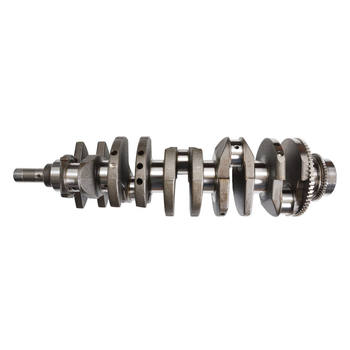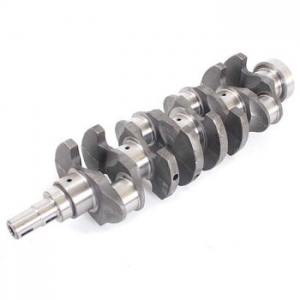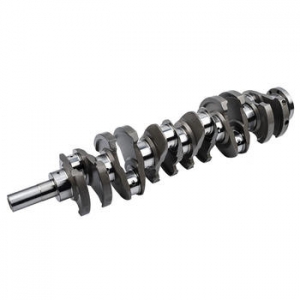The crankshaft is arguably the most critical component in an internal combustion engine. It's the part that translates the linear motion of the pistons into rotational motion, which ultimately drives your vehicle, powers industrial machinery, or propels a marine vessel. Think of it as the engine's backbone. Without a robust, precisely engineered crankshaft, the entire engine simply won't function, or worse, it will fail catastrophically. This underscores the immense importance of selecting a reliable engine crankshaft manufacturer. It's not just about buying a part; it's about investing in the heart of your power system. Choosing the right manufacturer means ensuring the crankshaft can withstand incredible stresses – torsional forces, bending moments, shear forces, and constant cyclic loading – often under extreme temperatures and pressures. It's a highly demanding role, and only manufacturers with deep expertise and rigorous processes can consistently produce parts up to the task. Have you ever stopped to consider the sheer engineering marvel packed into this single component?
The Heart of Power: Understanding Crankshaft Functionality
To truly appreciate the role of an engine crankshaft manufacturer, one must first understand the relentless forces a crankshaft endures. As each cylinder fires, the expanding gases push the piston down with tremendous force. This force is transmitted through the connecting rod to the crankshaft pin, causing the shaft to rotate. With multiple cylinders firing in sequence, the crankshaft experiences a rapid succession of these powerful impulses. These forces are not only significant in magnitude but also dynamic, constantly changing direction and intensity. The crankshaft must be stiff enough to resist bending and twisting, yet tough enough to avoid fatigue failure over millions of cycles. Its journals, where it rotates within the engine block and connects to the connecting rods, must maintain precise dimensions and surface finishes to ensure smooth operation and minimize wear. Frankly speaking, it's a part designed to live in a constant state of controlled violence. The demands placed on its material properties, geometric accuracy, and overall structural integrity are immense, making its manufacturing a highly specialized discipline requiring deep knowledge of metallurgy, machining, and structural analysis.
Materials Science: The Foundation of Crankshaft Strength
The journey of becoming a reputable engine crankshaft manufacturer begins long before machining starts – it starts with selecting the right material. The material dictates the crankshaft's inherent strength, toughness, and fatigue resistance. Common materials include forged steel alloys (like 4340, 5140, or similar compositions) and ductile cast iron. Forged steel generally offers superior strength and durability, making it the preferred choice for high-performance or heavy-duty applications. The forging process aligns the material's grain structure, enhancing its mechanical properties. Ductile cast iron, while less expensive, provides a good balance of strength and machinability, suitable for many passenger vehicle applications. Beyond the base material, heat treatments such as induction hardening or nitriding are often applied to the bearing surfaces (journals and fillets) to significantly improve wear resistance and fatigue strength. Choosing the appropriate material and heat treatment process is a critical decision made by an experienced engine crankshaft manufacturer, based on the intended application, performance requirements, and expected operating conditions. It's a complex interplay of material science and engineering requirements.
Crafting the Crankshaft: Forging and Casting Processes
Once the material is selected, the initial shape of the crankshaft is formed through either forging or casting. Forging involves heating a steel billet to a plastic state and then shaping it using dies and immense pressure. This mechanical working refines the grain structure and enhances the material's strength and toughness, creating a strong, dense component ideal for demanding applications. The typical forging process might involve multiple stages to achieve the complex crankshaft shape, including operations like blocking, finishing, and trimming. Casting, on the other hand, involves pouring molten metal into a mold. Ductile cast iron crankshafts are commonly produced this way. While casting can be more cost-effective for high-volume production and allows for more complex initial shapes, the resulting grain structure is generally less favorable for extreme loads compared to forging. An engine crankshaft manufacturer skilled in both methods can select the most appropriate process based on the design requirements, material choice, and target production volume. Both methods require precise control of temperature, pressure, and cooling rates to ensure the integrity and properties of the final component.
Precision Machining: Achieving Critical Tolerances
Following the initial shaping, the crankshaft undergoes a series of demanding machining operations. This is where the raw forging or casting is transformed into a highly precise engineering component. Operations include turning the main journals (where the crankshaft spins in the engine block) and rod journals (where connecting rods attach), milling the counterweights, drilling oil passages, and machining flanges and keyways. The accuracy required during these steps is astounding. Crankshaft journals must be machined to extremely tight tolerances – often measured in microns – for diameter, roundness, taper, and surface finish. The distances between journals (stroke) and their angular relationships are also critical for engine timing and balance. High-precision CNC machines are indispensable tools for an engine crankshaft manufacturer, allowing for repeatable accuracy and complex geometries. Achieving the required surface finish on the journals is also vital for lubrication and preventing wear; processes like grinding, microfinishing, and polishing are employed to achieve mirror-like surfaces. This phase is labor-intensive and requires highly skilled operators and advanced machinery to meet stringent quality specifications.
Balancing Act: Ensuring Smooth Engine Operation
A crankshaft, by its nature, has an uneven distribution of mass due to the cranks and counterweights. This imbalance, if not corrected, would lead to severe vibration in the engine, causing excessive wear on bearings, structural fatigue, and an unpleasant driving experience. Therefore, dynamic balancing is a crucial step in the manufacturing process performed by an engine crankshaft manufacturer. After machining, the crankshaft is placed on a balancing machine that spins it at high speed. Sensors detect any imbalances, and the machine identifies the location and amount of material that needs to be removed to achieve balance. This is typically done by drilling holes into the counterweights. The goal is to ensure that the rotational forces are minimized, resulting in smooth, reliable engine operation across its entire RPM range. Achieving precise balance is a key indicator of a quality crankshaft and a meticulous manufacturing process. Interestingly enough, the required level of balance can vary depending on the engine type and application, from relatively straightforward balancing for simple inline engines to complex balancing for V-configurations or high-performance engines.
Quality Control and Testing: Guaranteeing Reliability
For any reputable engine crankshaft manufacturer, quality control is not just a department; it's a philosophy ingrained in every step of the process. From inspecting raw materials for chemical composition and mechanical properties to rigorous in-process checks after each machining operation, quality is constantly monitored. Final inspection involves verifying critical dimensions using high-precision measuring equipment like CMMs (Coordinate Measuring Machines), checking for surface defects using magnetic particle inspection or dye penetrant testing to reveal even microscopic cracks, and hardness testing to ensure proper heat treatment. Fatigue testing, though often done on sample batches rather than every single crankshaft, is also vital to validate the design and manufacturing process's ability to withstand operational stresses over the engine's lifespan. Documentation of these tests and inspections is crucial for traceability and demonstrating compliance with industry standards. Without these stringent quality assurance measures, the reliability and safety of the final product cannot be guaranteed. What makes a crankshaft truly dependable? It's this unwavering commitment to checking, verifying, and validating at every stage.
Beyond Standard: Custom Engine Crankshaft Solutions
While many manufacturers focus on high-volume production of standard crankshafts for common engine types, a truly versatile engine crankshaft manufacturer often provides custom solutions. This is particularly important for niche applications, motorsport, antique engine restoration, or developing new engine designs. Customization can involve altering the stroke, journal sizes, counterweighting, or overall geometry to meet specific performance requirements or fit unique engine configurations. This demands not only manufacturing expertise but also significant engineering and design capabilities. Working closely with clients, a manufacturer providing custom engine crankshaft solutions can optimize the design for specific power goals, operating environments, or physical constraints. This often involves finite element analysis (FEA) to predict stress distribution and ensure the design's structural integrity before manufacturing even begins. It's a collaborative process that leverages the manufacturer's deep understanding of crankshaft mechanics and production capabilities to turn a client's specific needs into a tangible, high-performance reality. This capability distinguishes manufacturers who are merely producers from those who are true engineering partners.
Choosing the Right Engine Crankshaft Manufacturer: What to Look For
So, how do you go about choosing a reliable engine crankshaft manufacturer? It boils down to several key factors. First and foremost is experience and reputation. Look for manufacturers with a proven track record in producing crankshafts for applications similar to yours. Ask about their quality control processes and certifications (like ISO 9001 or IATF 16949). Investigate their material sourcing and heat treatment capabilities. Are they using high-quality materials and proven metallurgical processes? Evaluate their machining precision and equipment – do they utilize modern CNC machines and advanced measurement tools? Consider their engineering support and design capabilities, especially if you require custom work or technical assistance. A manufacturer who understands your specific needs and application is far more likely to deliver a product that meets your expectations. Frankly speaking, the cheapest option is rarely the best when it comes to such a critical engine component. Prioritize expertise, quality assurance, and technical capability over initial cost. A poorly made crankshaft can lead to extensive engine damage and costly repairs down the line.
Challenges in Industrial Crankshaft Manufacturing Process
The industrial crankshaft manufacturing process presents unique challenges compared to smaller automotive crankshafts. Industrial engines are often significantly larger, producing much higher torque and operating under continuous, heavy loads for extended periods. This requires even more robust materials, larger and more complex forgings or castings, and specialized machining equipment capable of handling massive components with extreme precision. Maintaining tight tolerances on journals that might be several inches in diameter and many feet long is a significant technical feat. The sheer scale of the components also complicates handling, heat treatment, and transportation. Ensuring the internal integrity of very large forgings or castings requires advanced non-destructive testing methods. Furthermore, the operational demands of industrial applications, such as power generation, marine propulsion, or heavy mining equipment, mean that failures are not just costly in terms of repair but can also result in significant downtime and lost productivity. Therefore, the stakes are incredibly high for an engine crankshaft manufacturer specializing in these heavy-duty applications, demanding the utmost rigor in design, materials, process control, and quality assurance.
In conclusion, the role of an engine crankshaft manufacturer is multifaceted and critical. It requires a deep understanding of materials science, complex manufacturing processes, precision engineering, rigorous quality control, and potentially, the ability to provide custom solutions. A crankshaft is not just a shaped piece of metal; it's a testament to engineering precision and material integrity designed to withstand immense forces under challenging conditions. Choosing the right manufacturer is paramount to ensuring the reliability, performance, and longevity of any engine. By focusing on expertise, quality, and capability, you secure a component that is truly the dependable heart of your power system. When evaluating potential partners, ask detailed questions about their processes and quality checks. Don't hesitate to request case studies or references. The investment in a high-quality crankshaft from a leading manufacturer pays dividends in terms of performance and peace of mind. For anyone seeking a high-quality, reliable partner for their crankshaft needs, understanding these fundamental aspects of manufacturing is the first step.
For more detailed information, please visit our official website: engine crankshaft manufacturer





